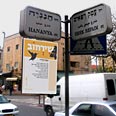
Be afraid; be very afraid
Walking in Jerusalem a precarious experience, as size dictates right of way
There is nothing more meaningful to me than walking the streets of Jerusalem. This has been a city of pedestrians for millennia. Omdot yahu ragleinu b’shaarayich Yerushalayim – “Our feet are standing at your gates, O Jerusalem” (Psalm 122.) While walking the city was sheer poetry for King David, for today’s pedestrian, Jerusalem is a dangerous place.
The festivals (shloshet haregalim) in particular underscore the ways in which there was an indelible relationship between the act of walking and the land of Israel. So during this period between Pesach and Shavuot, I can’t think of a more fitting gift to the State of Israel than the revocation of 3,600 driving licenses last week. Hach Sameach walkers everywhere!
As an enthusiastic pedestrian in the Holy City, each day I experience how precarious it is to walk here. Cars are routinely parked on sidewalks, forcing pedestrians to navigate their way amidst speeding cars racing down narrow residential streets. Even the stoplights here seem to be in cahoots with Israel’s infamously reckless drivers. While most world cities synchronize stoplights to allow pedestrians to cross all lanes of traffic before changing the signal to a green light for cars, here in Israel cars and trucks take precedence, changing the crossing signal from “walk” to “don’t walk” quickly and stranding pedestrians on narrow traffic islands until the signal changes again. Crossing a busy street like Derekh Hebron can require as many as three separate attempts.
But the notion that vehicles take priority over pedestrians is reinforced every day as we venture into those designated “pedestrian crossings” found throughout the country. While the white stripes and the picture of a person crossing the road are meant to indicate to drivers that they must yield to pedestrians, this is rarely the case in my experience. Instead, drivers and pedestrians play a game of “chicken.” If a pedestrian is brave enough to venture into the crosswalk, then chances are the cars will stop. At least most of the time.
Why is everyone in such a hurry?
Has anyone else deduced a default principle of the road here? From what I observe, drivers of all ages seem to think that size dictates the right of way. When a truck and a car meet at an intersection, the truck assumes it has the right of way. When an SUV and a small economy car encounter each other, there is the same response. Now, factor into this equation an adult, a child, or a bicycle. As they say on TV, don’t try this at home.
As a Diaspora Jew spending time in Israel, I know I tend to have unrealistically high expectations of life in the Jewish State. But should Jerusalem be a more difficult place for pedestrians than my native New York City? Am I naïve to expect that the Jewish sanctity for human life be applied to the roads?
Abraham Shlonsky likened the roads of Israel to the winding black tefillin straps. Those roads seemed to lead to community and progress. They connected an emerging nation. A very different kind of male imagery can be imagined to describe the roads of Israel some 80 years later, where the aggression of the battlefield and excessive testosterone seems to spill out into the streets. In this tiny country, why is everyone is such a hurry?
Rabbi Leon Morris is executive director of the Skirball Center for Adult Jewish Learning in New York, and is currently a Mandel Jerusalem Fellow










